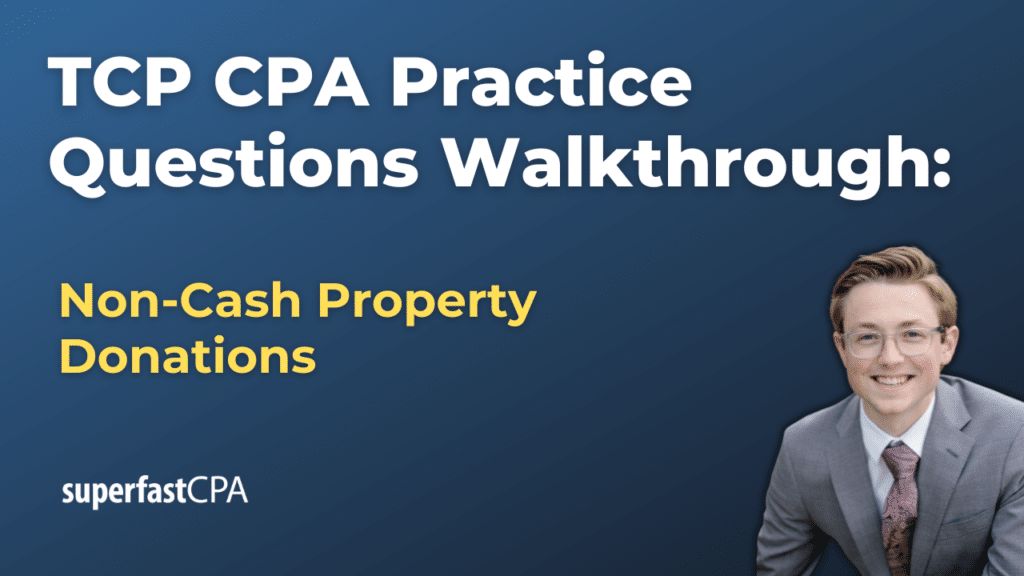In this video, we walk through 5 TCP practice questions teaching how non-cash property donations work as itemized deductions. These questions are from TCP content area 1 on the AICPA CPA exam blueprints: Tax Compliance and Planning for Individuals and Personal Financial Planning.
The best way to use this video is to pause each time we get to a new question in the video, and then make your own attempt at the question before watching us go through it.
Also be sure to watch one of our free webinars on the 6 “key ingredients” to an extremely effective & efficient CPA study process here…
Non-Cash Property Donations
Non-cash property donations are an important aspect of charitable giving, offering donors tax incentives while providing valuable resources to charities. However, these donations are subject to complex tax rules that vary based on the type of property donated, the donor’s adjusted gross income (AGI), and the nature of the receiving charity. Below, we explore these rules, focusing on AGI limits, donations to different types of charities, and special considerations for different kinds of property.
General AGI Limitations
The IRS sets several AGI-based limitations on deductions for non-cash property donations:
- 50% AGI Limit: This is the broadest limit, applicable primarily to ordinary income property donations to public charities. For non-cash donations like clothes, furniture, and electronic equipment that haven’t appreciated in value, this limit generally applies, allowing the donor to deduct the lesser of the fair market value or the cost basis of the donated items up to 50% of their AGI.
- 30% AGI Limit for Long-term Capital Gain Property: This limit is specifically for donations of capital gain property held for more than one year, such as stocks, bonds, and real estate, when donated to public charities. Donors can deduct the fair market value of such property up to 30% of their AGI. For instance, if Sarah has an AGI of $100,000 and donates stocks worth $40,000 that she’s held for more than a year, her deductible amount under this rule is limited to $30,000.
Donations to Private Foundations
- 20% of AGI Limit:
- When donating appreciated capital gain property (assets held for more than one year) to a private foundation, the deductible amount is generally limited to 20% of the donor’s adjusted gross income (AGI). This is a tighter restriction compared to the 30% AGI limit for similar donations to public charities.
- Excess over 30% of AGI to Public Charities:
- There’s an additional computation to consider if the donor has also made donations to public charities during the year. The rule specifies that the deduction for donations of appreciated capital gain property to a private foundation cannot exceed the lesser of:
- 20% of the donor’s AGI, or
- The excess of 30% of the AGI over the amount of property already donated to public charities.
- There’s an additional computation to consider if the donor has also made donations to public charities during the year. The rule specifies that the deduction for donations of appreciated capital gain property to a private foundation cannot exceed the lesser of:
Example:
Suppose the donor has an AGI of $100,000 for the year and considers the following charitable contributions:
- Donation of $35,000 to a public charity.
- Plans to donate additional capital gain property to a private foundation.
Here’s how you would calculate the maximum deduction for the donation to the private foundation:
- 30% of AGI limit for public charity: 30% of $100,000 = $30,000.
- Actual donation to public charity: $35,000 (over the 30% limit).
- Excess over 30% of AGI: The donor has exceeded the 30% limit with public charity donations. The excess calculation is $35,000 (cash donation) – $30,000 (limit) = $5,000.
Thus, when considering a donation to a private foundation:
- 20% of AGI: 20% of $100,000 = $20,000.
- Lesser amount for private foundation: The lesser of $20,000 or the $5,000 excess must be considered. In this case, $5,000 is the limit for the donation to the private foundation because it is the lesser amount.
Special Considerations for Different Types of Donated Property
- Tangible Personal Property: If the donated property’s use by the charity does not relate to the charity’s mission (known as “unrelated use”), the deduction is limited to the cost basis of the property. For example, if Mark donates a painting valued at $20,000 to a charity that sells it to fund activities unrelated to its mission, he can only deduct what he originally paid for it, say $5,000, even if the charity is a public one.
- Intellectual Property: Donations of intellectual property, such as patents or copyrights, follow different rules, where the deduction is often based on the income produced by the property or a statutory formula.
Carryover Rules
If the total deductible amount for a non-cash donation exceeds the applicable AGI limitation in a year, the excess can be carried forward and used in up to five subsequent tax years. This carryover applies until used up or time expires, whichever comes first.













